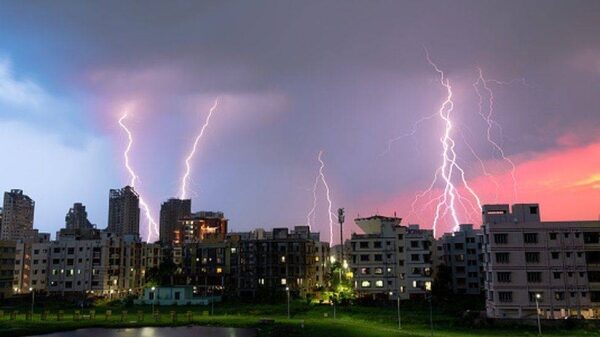
India recorded more than 18 million lightning strikes between April 2020 and March 2021.
Last March, four gardeners working in a condominium in Gurgaon, a suburb near the Indian capital, Delhi, took shelter under a tree during a downpour.
Within minutes, an orange flash raced down the trunk followed by pealing thunder. Lightning usually lasts under a second. A typical lightning flash measures about 300 million volts and 30,000 amps - enough to kill. It can cause the air around it to heat up to temperatures that are five times than that on the surface of the sun.
The four men fell to the ground. One of them died, while the others survived with burns.
"I don't remember what happened to me and how it happened. In a matter of seconds, everything was destroyed," one of the survivors told a newspaper.
His colleague was one of the more than 2,500 Indians who lose their lives to lightning every year. Lightning strikes have killed more than 100,000 people in the country between 1967 and 2019, according to official data. This is more than a third of fatalities caused by natural hazards during this period. Survivors might have to live with symptoms such as weakness, dizziness and memory loss.
India's meteorological office began lightning forecasts three years ago. Mobile apps now track flashes. People are alerted over radio, TV and megaphone-toting volunteers. A three-year-old initiative called Lightning India Resilient Campaign is working hard to raise awareness in lightning-prone villages and reduce deaths.
But the number of strikes have also risen sharply.
India recorded more than 18 million lightning strikes between April 2020 and March 2021, according to a study by the Delhi-based Centre for Science and Environment and climate magazine Down to Earth. This was a 34% rise over a similar period during the previous year. Satellite data gathered by the Indian Institute of Tropical Meteorology also shows strikes had "increased rapidly" between 1995 and 2014.Although half-a-dozen states recorded a bulk of the strikes, three states - Odisha, Jharkhand and West Bengal - accounted for 70% of the deaths. Men working in farms are most vulnerable.
"There are a lot of lightning strikes in our area. I still remember a seven-year-old boy getting killed when he went out during a storm to fetch their buffalo. Now we just try to stay at home," says Sandhyarani Giri, a school teacher in West Bengal.
Ms Giri lives in a thickly populated fishing village in Fraserganj bordering Bay of Bengal, some 120km (74 miles) south of the state capital, Kolkata. It's a lightning hotspot of sorts - about 60 people die every year due to lighting in the South 24-Parganas district, where her village is located.
The coastal villages present a landscape of land and water: farms, ponds and tin-roofed and thatched homes. Living next to the sea can be precarious: cyclonic storms and tidal surges are common. Lightning is more likely to occur over land, but waters off the coast are most often affected.
Lighting strikes are essentially a release of electricity mostly caused by imbalances within the storm clouds. So villagers have helped raise awareness and cut lightning deaths here by making cheap, homegrown lightning conductors to direct the electrical charge to the earth.
To make these conductors, villagers use second-hand bicycle wheel rims, bamboo and metallic wires. The rim is fixed on the top of a bamboo pole - sometimes up to 30ft high - which is strapped to buildings, mainly community centres and local schools. The conductor makes sure that the electricity generated will pass to the earth without causing any harm.
The overwhelming majority of India's lighting victims live in villages and die after taking shelter under tall trees, according to studies conducted by Lightning Resilient India Campaign. Tribespeople who farm, fish and forage for a living are especially vulnerable. The campaign has cut lightning deaths by 60% in some states.
"But there's a lack of community driven safety awareness campaigns by governments to reach the really vulnerable people at hotspots like farms, jungles, sea, coasts, ponds, lakes and rivers," says Col Sanjay Srivastava, convener of the campaign.
(Read more
here)
Source: BBC
Reader Comments
to our Newsletter